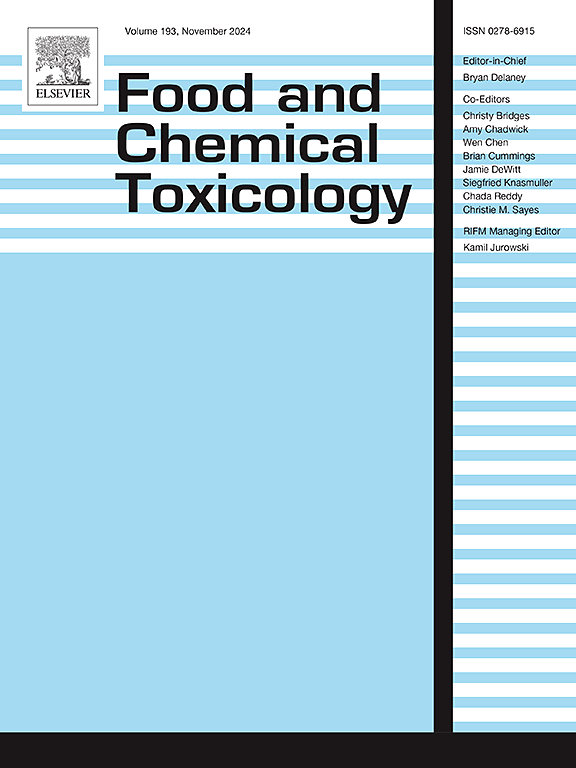意大利市场薯片/薯片丙烯酰胺含量测定及风险评估
IF 3.9
3区 医学
Q2 FOOD SCIENCE & TECHNOLOGY
引用次数: 0
摘要
丙烯酰胺在食品工业中是一个重要的问题,因为它可以在高温烹饪的食物中形成,主要是蔬菜来源的,富含碳水化合物。在本研究中,我们检测了意大利市场上五个品牌的薯片/薯片中的丙烯酰胺含量,并通过食用薯片/薯片进行了与丙烯酰胺暴露相关的风险评估。共制备50份样品,采用高效液相色谱法测定丙烯酰胺含量。丙烯酰胺平均含量为1116.6±585 μg/kg, 5个品牌中有2个品牌的丙烯酰胺含量较高。EDI值在0.172 ~ 0.901 μg/kg bw/day之间。LCR值为8.61 × 10−5 ~ 4.51 × 10−4。THQ值均小于1。MOEc值在189 ~ 987之间(平均478),明显低于10000的阈值,表明存在潜在的致癌风险。MOEn值范围从477到2496(平均1208),高于100表明没有神经毒性风险。需要进一步的研究来提出适当的干预措施,以减少食品中的丙烯酰胺含量。本文章由计算机程序翻译,如有差异,请以英文原文为准。
Determination of acrylamide levels in chips/crisps on the Italian market and exposure risk assessment
Acrylamide is an important concern in the food industry because it can form during cooking at high temperatures of foods, mainly of vegetable origin, and rich in carbohydrates. In this study, we detected the acrylamide levels in chips/crisps from five brands available on the Italian market and performed the risk assessment related to the exposure to acrylamide through the consumption of chips/crisps.
A total of 50 samples were prepared and the acrylamide levels were determined by HPLC.
The mean acrylamide value was 1116.6 ± 585 μg/kg, and two out of five brands showed higher values. EDI values were between 0.172 and 0.901 μg/kg bw/day. The LCR values ranged from 8.61 × 10−5 to 4.51 × 10−4. The THQ values were all below 1. The MOEc values ranged from 189 to 987 (mean 478), significantly lower than the 10000 threshold, indicating a potential carcinogenic risk. MOEn values ranged from 477 to 2496 (mean 1208), with values above 100 suggesting no neurotoxic risk.
Further research is needed to suggest appropriate interventions to reduce acrylamide levels in foods.
求助全文
通过发布文献求助,成功后即可免费获取论文全文。
去求助
来源期刊

Food and Chemical Toxicology
工程技术-毒理学
CiteScore
10.90
自引率
4.70%
发文量
651
审稿时长
31 days
期刊介绍:
Food and Chemical Toxicology (FCT), an internationally renowned journal, that publishes original research articles and reviews on toxic effects, in animals and humans, of natural or synthetic chemicals occurring in the human environment with particular emphasis on food, drugs, and chemicals, including agricultural and industrial safety, and consumer product safety. Areas such as safety evaluation of novel foods and ingredients, biotechnologically-derived products, and nanomaterials are included in the scope of the journal. FCT also encourages submission of papers on inter-relationships between nutrition and toxicology and on in vitro techniques, particularly those fostering the 3 Rs.
The principal aim of the journal is to publish high impact, scholarly work and to serve as a multidisciplinary forum for research in toxicology. Papers submitted will be judged on the basis of scientific originality and contribution to the field, quality and subject matter. Studies should address at least one of the following:
-Adverse physiological/biochemical, or pathological changes induced by specific defined substances
-New techniques for assessing potential toxicity, including molecular biology
-Mechanisms underlying toxic phenomena
-Toxicological examinations of specific chemicals or consumer products, both those showing adverse effects and those demonstrating safety, that meet current standards of scientific acceptability.
Authors must clearly and briefly identify what novel toxic effect (s) or toxic mechanism (s) of the chemical are being reported and what their significance is in the abstract. Furthermore, sufficient doses should be included in order to provide information on NOAEL/LOAEL values.
 求助内容:
求助内容: 应助结果提醒方式:
应助结果提醒方式:


